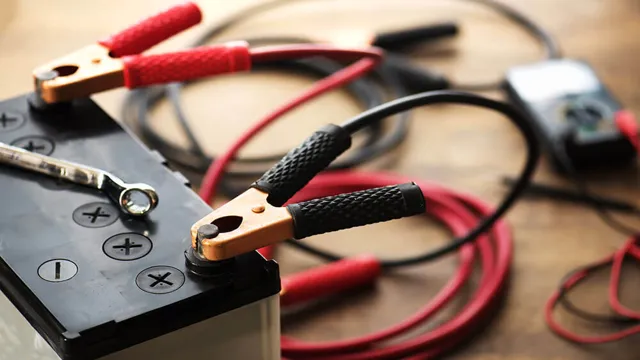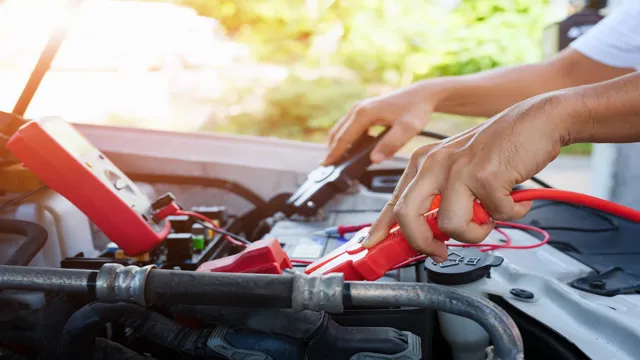Top 5 Reasons Why Your Car Won’t Start Even with New Battery and Starter – Troubleshooting Guide
We’ve all been there before – you turn the key in the ignition, but instead of the engine roaring to life, you’re met with the sound of silence. After checking the battery and starter, you might be scratching your head wondering why your car still won’t start. It’s a frustrating and puzzling situation, and one that can be difficult to diagnose on your own.
There are a few reasons why your car might fail to start, even with a brand new battery and starter. It could be an issue with the alternator, the fuel system, or even a faulty ignition switch. These problems can all prevent your car from starting, and they require a bit of investigation to pinpoint the root cause.
In this blog post, we’ll take a closer look at why your car won’t start with a new battery and starter. We’ll explore common issues that could be causing the problem, and we’ll provide tips on how to diagnose and fix the issue. Whether you’re a seasoned gearhead or a beginner when it comes to car maintenance, we hope this post will help you get your vehicle back up and running in no time.
Check the Electrical Connections
If you’ve recently replaced your car’s battery and starter but it still won’t start, the next step is to check the electrical connections. Quite often, poor connections can be the culprit even if you have a brand new starter and battery installed. Check all the electrical connections, especially the battery terminals and the starter solenoid.
Over time, these connections can become corroded and loose, leading to poor electrical conductivity. This can result in a weak or absent current flowing through the system and keeping your car from starting. Ensure that all connections are tight and free of corrosion, and if you find any, clean them up with a wire brush or sandpaper.
Once you’ve finished checking and cleaning the connections, give your car another try and see if it starts up. If the problem persists, it may be time to call a mechanic to diagnose and repair any underlying issues.
Inspect the Battery Cables
When inspecting your car’s battery, it’s essential to check the electrical connections, especially the battery cables. These cables are a vital component in ensuring your car’s electrical system works correctly. If there’s any rust, corrosion, or damage to the battery cables, it could cause your car to experience electrical problems.
The first thing to do is to disconnect the negative cable and then the positive cable. Ensure they are tight and firm when connecting them back. If you notice any damage or rust, you can use a wire brush to remove the corrosion gently.
It’s important to note that different car models may have different types of battery connections. Some may have side-mounted terminals, while others may have top-mounted terminals. Whatever type of connection your car has, ensure you examine and clean them regularly.
Your car’s electrical system relies on the battery to function correctly, so keeping the cables in good condition is paramount to your car’s longevity.

Verify the Ground Connection
When dealing with electrical connections, verifying the ground connection is crucial. This is because the ground connection provides a safe path for electrical current to enter and exit any device. To test the ground connection, you can use a multimeter to measure the resistance between the ground pin on the power cord and the grounded metal chassis of the device.
If the resistance is low, then the ground connection is working well. In cases where the resistance is high or non-existent, you may need to replace the power cord or call in a professional electrician to fix the grounding issue. Always remember to turn off the device and unplug it before testing any electrical connections to avoid electrocution.
Neglecting to verify the ground connection could lead to electrical shock, fires, or even damage to the device itself. In other words, checking the ground connection is like making sure the foundation of a house is sturdy to prevent it from collapsing.
Test the Alternator
So, you just installed a new battery and starter in your car, but it still won’t start? That can be pretty frustrating. Before you start tearing your hair out, there’s one more thing you should check – the alternator. The alternator is responsible for charging your car’s battery as well as providing electricity to power all the electrical components.
If your alternator is faulty, it could be the reason why your car won’t start, despite having a new battery and starter. To test your alternator, you’ll need a voltmeter. First, make sure the car is turned off and the keys are removed from the ignition.
Next, locate the alternator under the hood of your car. There should be two wires connected to the back of the alternator – one red and one black. Use a wrench to remove the black wire from the alternator and keep it away from any metal parts of the car.
Turn on the voltmeter and set it to DC volts. Connect the positive lead of the voltmeter to the positive terminal of the battery and the negative lead to the disconnected black wire. Start the car and rev the engine to around 2000 rpm.
If the reading on the voltmeter is between 15 and 15 volts, your alternator is working properly.
If the reading is lower than 13 volts, your alternator could be faulty and in need of replacement. By testing your alternator, you could solve the mystery of why your car won’t start despite having a new battery and starter. If replacing the alternator doesn’t solve the problem, it’s best to take your car to a mechanic to get it diagnosed and fixed.
Use a Multimeter to Check Voltage
If you suspect an issue with your car’s alternator, it’s important to test it before it causes any further damage. One way to do this is by using a multimeter to check the voltage. Start by turning on the engine and letting it run for a few minutes.
Then, use the multimeter to measure the voltage across the battery terminals. A healthy alternator should output around 14 volts, while a reading of 12 volts or less suggests a problem. If the voltage is low, try revving the engine to see if the reading increases.
If not, it may be time to replace the alternator. Don’t let a bad alternator leave you stranded on the side of the road – use a multimeter to test it and catch any issues before they escalate.
Check the Alternator Belt
When it comes to maintaining your vehicle, one component that should never be overlooked is the alternator belt. We rely on our cars to get us from point A to point B, and a faulty alternator belt can lead to total engine failure. To test your alternator belt, start by examining its condition.
If the belt looks cracked or frayed, it’s time for a replacement. You can also use a belt tension gauge to check its tension – a loose belt may slip, while a belt that’s too tight can put unnecessary strain on the engine. Test the alternator itself by running the engine and checking the voltage output with a multimeter.
A healthy alternator should output around 13-14 volts. By keeping your alternator belt in good condition, you can avoid the hassle of a breakdown and ensure your vehicle stays running smoothly on the road.
Inspect the Alternator Connections
Inspecting the alternator connections is a crucial step in testing the alternator. The alternator produces electrical energy that powers various components of the vehicle. The connections must be free of corrosion and securely fastened to ensure proper functioning.
Corrosion can impede the flow of electricity, causing the alternator to work harder than it should. Loose connections can cause the alternator to malfunction, resulting in a dead battery. To inspect the connections, visually inspect the cables for any signs of wear and tear, such as frayed wires or damaged insulation.
Use a multimeter to check the voltage at the battery terminals while the vehicle is running. If the voltage is below 18 volts, there may be a problem with the alternator or the connections.
In conclusion, regularly inspecting and maintaining the alternator connections can save you from expensive repairs down the line.
Troubleshoot the Starter Circuit
Despite installing a new battery and starter, your car still refuses to start. No electricity is reaching the starter, indicating that there is an issue with the starter circuit. Diagnosing the problem may require some troubleshooting.
First, check the battery terminals and ensure they are clean and not corroded. Next, examine the cables and connections between the battery and the starter, ensuring that they are not frayed or loose. If all these components seem to be in good condition, then you may need to test the starter itself.
To do so, connect a test light to the starter’s electrical connector while a friend tries to start the car. If the light illuminates, then the starter is working, and you need to investigate the wiring. However, if no light appears, then the starter itself is likely the problem, and it will need to be replaced.
Troubleshooting the starter circuit may be a somewhat tedious process, but it’s vital to remember that systematic investigation is key, and it may help save you a significant amount of money.
Check the Ignition Switch
If you’re having trouble starting your car, it may be due to a malfunctioning starter circuit. One of the first things you should check is the ignition switch. The ignition switch is responsible for sending power to the starter motor when the key is turned.
If the ignition switch is faulty, it can prevent the starter from receiving power and cause your car to not start. To troubleshoot the starter circuit, you can use a multimeter to test the voltage at the ignition switch and ensure it is sending power to the starter motor. If the voltage is low or non-existent, you may need to replace the ignition switch.
It’s important to diagnose and fix starter circuit issues quickly, as leaving them unresolved can cause further damage to your car’s electrical system.
Test the Starter Relay
If you’re having trouble starting your vehicle, it could be an issue with the starter circuit. One way to troubleshoot this is by testing the starter relay. The starter relay is the component that sends a signal from the ignition switch to the starter motor, allowing it to engage.
To test the relay, start by locating it in your vehicle’s fuse box. You can then use a multimeter to check for continuity in the relay’s contacts. If you find there’s no continuity, it’s time to replace the relay.
On the other hand, if the starter still doesn’t engage after replacing the relay, it may be a sign of a deeper issue in the starter circuit. Remember, testing the starter relay is just one step in troubleshooting your vehicle’s starting issues. If you’re not comfortable doing this yourself, it’s best to take your car to a trusted mechanic for further diagnosis and repair.
Bring Your Car to a Professional Mechanic
If your car won’t start and there is no electricity despite installing a new battery and starter, then it can be a frustrating and confusing situation. One common reason for the problem could be a faulty alternator. The alternator is responsible for charging the battery and powering the electrical systems while the car is running.
If it is not functioning properly, then the battery will not get charged, and the car won’t start. Another possible reason could be a malfunctioning ignition switch or a blown fuse. These issues can only be diagnosed and fixed by a professional mechanic.
Attempting to fix the problem on your own can be dangerous and may lead to further damage to your vehicle. Therefore, bringing your car to a professional mechanic is the best and safest option. They have the tools, experience, and expertise to diagnose and repair the issue quickly, efficiently, and correctly, ensuring your car is back on the road in no time.
Conclusion
Looks like it’s time to call Ghostbusters, because this car seems possessed by some serious spectral energy! But in all seriousness, it could be a number of things causing the lack of electricity and the new battery and starter not doing their job. From faulty wiring to a malfunctioning alternator, it’s important to bring in a professional to exorcise these issues and get your ride back on the road.”
FAQs
What are the possible reasons why my car won’t start even with a new battery and starter?
The issue may be due to a faulty alternator, corroded battery terminals, a broken or loose alternator belt, or a faulty ignition switch.
How can I tell if it’s my alternator that’s causing my car’s lack of electricity?
The best way to test your alternator is to use a multimeter to check its voltage output. Alternatively, you could take your car to a mechanic for diagnosis.
Is there anything I can do to prevent my battery from becoming corroded?
One preventative measure is to clean your battery terminals regularly using a wire brush. You may also want to use a protective spray or grease to help prevent future corrosion.
Can a dead battery cause my starter to fail?
In some cases, a drained battery can put too much strain on your starter motor, causing it to fail prematurely. However, it’s more likely that a faulty starter was the root cause of the issue in the first place.






